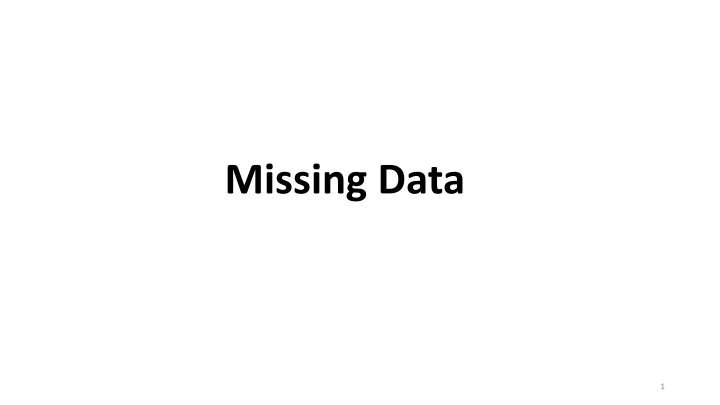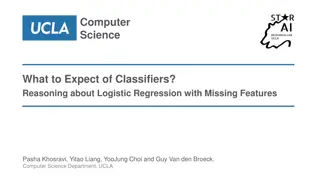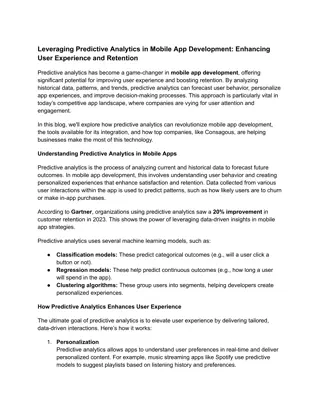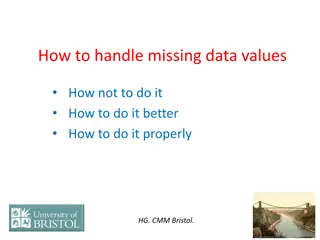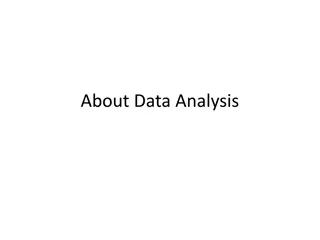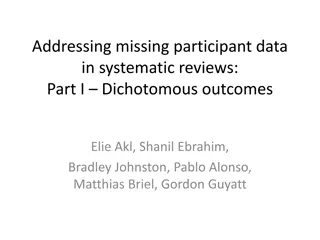Strategies for Handling Missing Data in Predictive Modeling
Handling missing data is crucial in predictive modeling to ensure accurate and reliable results. This content discusses various strategies such as complete-case analysis, imputation methods, and creating missing indicators to address missing values. It also emphasizes the importance of scoring new cases accurately despite missing data.
Download Presentation

Please find below an Image/Link to download the presentation.
The content on the website is provided AS IS for your information and personal use only. It may not be sold, licensed, or shared on other websites without obtaining consent from the author.If you encounter any issues during the download, it is possible that the publisher has removed the file from their server.
You are allowed to download the files provided on this website for personal or commercial use, subject to the condition that they are used lawfully. All files are the property of their respective owners.
The content on the website is provided AS IS for your information and personal use only. It may not be sold, licensed, or shared on other websites without obtaining consent from the author.
E N D
Presentation Transcript
Choices: Complete Case Imputation 2
Complete-case analysis has attractive theoretical properties even when the missingness depends on observed values of other inputs. Complete-case analysis has serious practical shortcomings with regards to predictive modeling. 3
The essential question is scoring all new cases (even with missing data) to be required? 4
A reasonable strategy for handling missing values in predictive modeling Create missing indicators and treat them as new input variables in the analysis. Use median imputation for numeric inputs. Fill the missing value of xj with the median of the complete cases for that variable. Create a new level representing missing (unknown) for categorical inputs. 5
With this strategy a new case is easily scored. Replace the missing values with the medians from the development data and then apply the prediction model. 6
Some notes (from a SAS document on predictive modeling) There is a large statistical literature concerning different missing value imputation methods, including discussions of the demerits of mean and median imputation and missing indicators (Donner 1982, Jones 1997). Most of the advice is based on considerations that are peripheral to predictive modeling. There is very little advice when the functional form of the model is not assumed to be perfectly specified, when the goal is to get good predictions that can be practically applied to new cases, when p-values and hypothesis tests are of secondary importance, and when the missingness might be highly pathological, in other words, depending on lurking predictors. 7
A note on complete case analysis for this data set. 8
proc proc sql from dictionary.columns where libname="D" and memname="DEVELOP"; select name into : vars separated by "," from dictionary.columns where libname="D" and memname="DEVELOP" and type="num" ; quit quit; %put &vars; data data tmp(keep=nummiss); set d.develop; nummiss=nmiss(&vars); run run; proc proc freq freq data=tmp; tables nummiss; run run; sql; select name,type 9
proc proc sql select * from d.developlevels ; select count(*) from d.developlevels where nmisslevels ne 0 0 ; select tablevar into : missvars separated by " " from d.developlevels where nmisslevels ne 0 0 ; quit quit; %put &missvars; sql; 10
Create imputation indicators %let imputed=MIAcctAg MIPhone MIPOS MIPOSAmt MIInv MIInvBal MICC MICCBal MICCPurc MIIncome MIHMOwn MILORes MIHMVal MIAge MICRScor; data data d.develop_a(drop=i); set d.develop_a; /* define the missing indicator variables */ array mi{*} &imputed; array x{*} &missvars; do i=1 1 to dim(mi); mi{i}=(x{i}=. .); end; run run; proc proc means means data=d.develop_a; var &imputed; run run; 11
Now do median imputation. proc proc stdize stdize data=d.develop_a reponly /*Replaces missing data with the location measure method=median out=d.imputed; var &missvars; run run; (does not standardize the data)*/ proc proc print print data=d.imputed(obs=25 var ccbal miccbal ccpurc miccpurc income miincome hmown mihmown; run run; proc proc means means data=d.imputed nmiss; run run; 25); 13
Alternatives Regression Imputation Build k linear regression models, one for each input variable with missing data, using the other inputs as predictors. (k is the number of variables with missing values.) Complication -- the other inputs may themselves have missing values => the k imputation regressions also need to accommodate missing values. 15
Alternatives Cluster Imputation Cluster the cases into relatively homogenous subgroups Use mean-imputation within each group For new cases with multiple missing values, use the cluster mean that is closest in all the nonmissing dimensions. 16
Alternatives Form logical groups and use mean imputation within groups. 17
